Specifying Real Wood Veneer: Versatile, Economical, Sustainable
Veneer profile wrapping and laminating boosts wood's green quotient, reduces costs and encourages design creativity
![]() Continuing Education
Continuing Education
Use the following learning objectives to focus your study while reading this month’s Continuing Education article.
Learning Objectives - After reading this article, you will be able to:
- Compare the two primary veneer processes: veneer profile wrapping and flat lamination.
- Explain the sustainability benefits of veneer profile wrapping and lamination.
- Identify and apply options available for both veneer and core material.
- Identify situations where profile wrapping or lamination may be the best design and environmental option.
- Discuss the production process.
- Explain the concept of shared responsibility as it relates to resource efficiency when specifying wood products.
Wood is an inherently green building material, offering design professionals product durability, longevity, design creativity, and aesthetics. When properly sourced or environmentally certified, and used efficiently, wood’s environmental advantages are magnified.
Architects, design professionals and organizations involved in the building design process play a critical role in ensuring resource efficiency when specifying materials. As we will outline in this course this is particularly important in how wood products are specified, as there can be significant resource efficiencies gained when specifying the use of profile wrap veneered or flat laminated products.
With the shared recognition that all our natural resources must be wisely managed, there are growing numbers of ways to judiciously use wood-based materials without compromising sustainability, aesthetics or structural stability - and many of them come with favorable cost and design implications.
An increasingly popular option for efficiently specifying architectural millwork and mouldings is the use of veneer profile wrapping and laminating, which involves applying real wood veneer to a substrate or core that has been engineered and shaped to meet specific design criteria.
Initially developed as a process to create sustainable, cost-effective, easy-to-handle (and install) alternatives to existing solid wood moulding and millwork products, veneer profile wrapping and laminating have quickly proven themselves as unique process solutions to both standard products and design challenges. Wrapping a simple, common moulded substrate is barely scratching the potential of the veneer technology process.
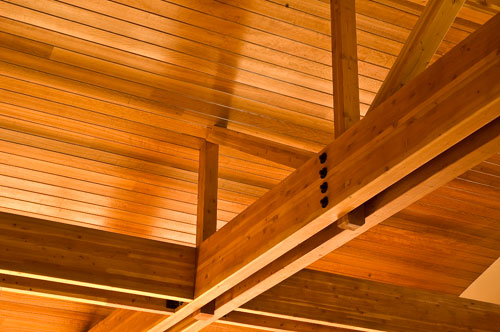 |
Cherry veneer profile wrapped wood paneling was used on the ceiling of this commercial bank branch location on Washington State’s Olympic Peninsula, resulting in the aesthetic look sought by the design team at significant cost savings. Photo courtesy of Contact Industries |
"As design professionals come to understand the manufacturing process and become more familiar with, and better understand, what can be achieved through veneer profile wrapping and laminating we, as manufacturers, are gratified by the greater sense of creativity that ultimately results," says Peter McKibbin, Vice President, Contact Industries, an Oregon-based profile wrapping and laminating concern. "Many of the products manufacturers have developed are a direct result of specific design or product requirements initially created by and requested by a design team. After the design intent is discussed, it becomes very much a matter of executing on the principals' product vision."
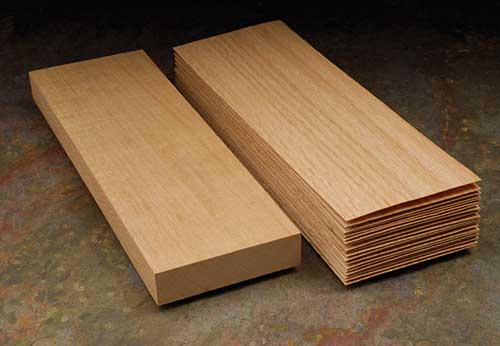 |
Profile wrapping manufacturers can get as many as 50 sheets of veneer from a single clear block of lumber. Photo courtesy of Contact Industries |
Over the years, the creativity of design professionals has resulted in all manner of new products that, in addition to pushing the design envelope, are more robust from an engineering perspective, easier to handle, more sustainable, generate less job site waste and, very often, are more cost effective.
“As the architectural community becomes more aware of the inherent benefits of profile wrapping and flat lamination,” McKibbin said, “designers are increasingly becoming conscious of the role they play in ensuring these technologies are applied by specifying their use in construction documents.
“Because the technologies are new relative to the general use of solid wood products, the specification factor is often overlooked.”
Manufacturers alone can go only so far in developing technologies and product advances that can have beneficial effects on sustainability efforts. These technologies are often useless without those in the design community understanding their benefits and specifying them for use in the building they design. Too often, more harmful traditional building practices are carried out because the design team failed to specify where new technologies and products should be applied.
This article will cover some of the product and design possibilities that can be achieved with veneer profile wrapping and laminating, describe the advantages and limitations of the process methods and highlight the steps involved in the process itself.
Veneer Profile Wrapping and Lamination - The Basics
The process of veneer profile wrapping has evolved over the last three decades from adhering vinyl overlays to traditional moulding patterns to the specification of a hundred plus of types species of veneers, profile wrapped on a wide variety of substrates of all shapes and substances.
Today, there are two primary types of veneer application techniques: 1) Profile wrapping, which is a lineal manufacturing process; and 2) flat lamination, a more traditional batch process.
Manufacturers note that with today's advanced technology and materials, both types of veneered product processes offer design professionals greater opportunity to better and more sustainably manage the volume of clear lumber consumed when designing mouldings and millwork.
Veneered components are often superior in performance to the solid woods they replace in terms of lower installed cost, and aesthetic standards, with minimal impact on the fiber resource environment.
Resource Efficiency. By using high-value veneer only on the visible surfaces and lower-grade, sustainable fingerjoint or composite material for a substrate, profile wrapping manufacturers can extend the solid, clear wood resources by as much as 50 times.
Traditionally, a solid clear blank of 5/4 hardwood lumber might make a single moulding profile. However, with today’s sophisticated veneer slicing process technology manufacturers can generate as many as 50 identical finished products from that very same single slicing blank - hence the ‘extension’ of the resource.
This is achieved by slicing thin veneers (.013 to .015 of an inch), and wrapping those veneers over a profile moulded from lower-grade, sustainably produced finger-jointed pine or other readily available specified substrate.
Veneer can be made even more efficient and aesthetically pleasing by a process that finger joints the pieces back together to create long rolls of clear veneer. Additionally, in this process veneer can be color- and grain-matched, making the finger joints virtually impossible to notice.
Veneer wrapped solutions can also mean lighter shipments, easier racking, more dimensionally stable finished products and access to a wide variety of clear, long-length, solid products that, from flooring transitions and stair rails, to mouldings and tongue and groove paneling, maximize valuable lumber resources.
Companies that mill solid hardwood mouldings from clear lumber can have up to 60 percent utilization waste with a significant amount of off-fall as they work to meet a specification.
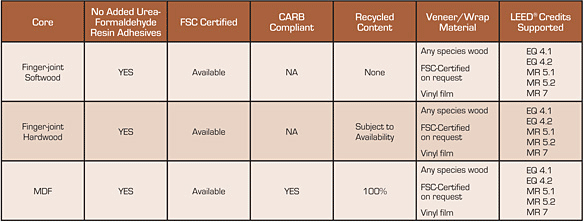 |
Veneered mouldings and millwork support LEED credits. Source: Contact Industries |
In contrast, the profile wrapping process is known to achieve a 95 percent utilization rate of all the raw material wood in usable products. In some instances, manufacturers have used the remaining 5 percent waste in balers to generate electricity that is fed into the local power grid, resulting in full utilization of the resource.
Enhanced Sustainability. The inherent sustainability of veneered products can be assured through the specification and use of certified substrates and veneers.
To ensure the highest sustainability quotient, architects should confirm that any of the wood-based core materials-- including softwood, hardwood, medium density fiberboard (MDF) and laminated veneer lumber (LVL)-- are certified by the Forest Stewardship Council (FSC) or the Sustainable Forest Initiative (SFI).
FSC chain of custody certification provides assurance regarding the production path taken by raw materials from the forest to the consumer, including all stages of processing, transformation, manufacturing and distribution. Most any veneer and core wood can be sourced with FSC forest certification, and products thus certified can be used to support needed credits in up to six different U. S. Green Building Council Leadership in Energy and Environmental Design (LEED) categories.
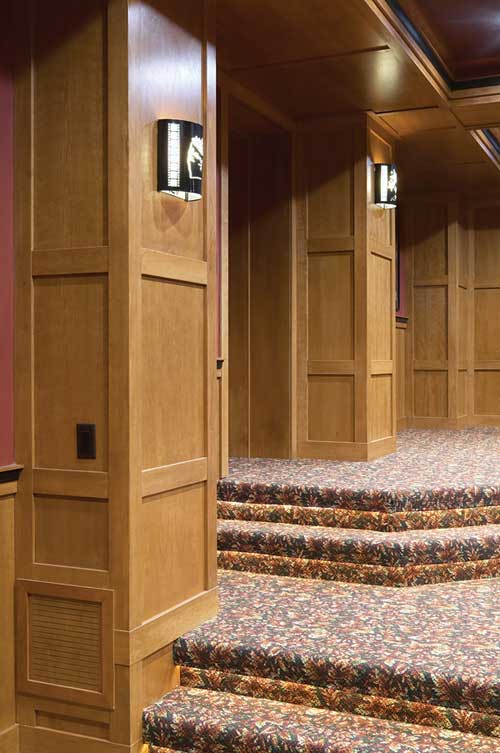 |
Cherry veneer wrapped mouldings resulted in a 30 percent savings over solid wood at the Hills of Troy development in Wisconsin. Photo courtesy of Contact Industries |
Installation Considerations. Advanced finger jointing technology with grain-matching veneer has enabled manufacturers to provide profile wrapped products in 14-foot, 16-foot and, now, 18-foot lengths –
This result difficult to achieve in both quantity and quality when using solid hardwood lumber.
With these lengths, most surfaces will require no end joints, resulting in a clear, defect-free board stretching the full length of the walls and ceilings in many applications, significantly reducing the occurrence of joints in all applications.
Ceiling applications, in particular, are much simpler to handle, and easier to install, when veneered boards are long enough to span the entire room.
Long-length products can be installed in one piece, so installation is faster and less costly than random length solid mouldings because there are fewer joints to scarf and nail.
In addition, veneer profile wrapped products require minimal surface preparation, result in fewer seams, and do not require pre-drilling as most solid hardwood mouldings would.
And because they can be produced to specified lengths, job site waste is significantly reduced, as is the impact on the environment and the wood fiber resource.
Reductions in installed cost of wrapped products versus solid wood equivalents can be dramatic. The Hills of Troy, a master planned community located in Wisconsin near the Twin Cities, is a 270-acre development with more than 70 acres devoted to conservation and crisscrossed by scenic nature trails and recreation areas. Builders of the homes sought to complement the natural exterior environment, and specified hardwood veneered mouldings using a finger-jointed pine substrate. Some 5,000 lineal feet of cherry veneer-wrapped mouldings including crown, base, window and door trim, cove ceiling and stair parts throughout each house were used. The savings on the installed cost of the wrapped products compared to solid cherry hardwoods: 30 percent.
Performance. While production of standard wrapped components remains prominent in the industry, increasingly, profile veneer wrapping comes as a design solution to an architect's or other end user's request. Some manufacturers maintain that a large part of their annual output represents one-of-a-kind solutions to unique situations, which may never be used again.
“While the specific details of a product often are unique, we frequently find that once an application has been utilized, such as real wood veneer applied to a roll-formed aluminum substrate, others in the design community find new ways to utilize that same technology,” McKibbin said.
With today's sophisticated no added formaldehyde (NAUF) polyurethane moisture curing adhesive technology, veneer-wrapped products have eliminated de-lamination concerns, enabling them to be more dimensionally stable than solid wood, with less warping and cracking.
And profile wrapped products can often perform where a solid wood component cannot, because solid wood may be too heavy, unwieldy, and/or difficult to produce to a defined specification, veneered products offer a design solution that may not have previously existed.
Case in point: the veneer wrapped solution specified by Zimmer Gunsul Frasca Partnership as architects for UC Berkeley's new Stanley Hall. The Portland, Oregon-based architectural group was unable to use cedar wood soffits, as the International Building Code does not allow solid wood for this application. Design integrity was maintained and the fire-rating dilemma was overcome by profile-wrapping a western red cedar veneer over custom-formed aluminum profiles. Some 290 ten-foot long profile wrapped pieces were installed as third and eighth story soffits on the building, which is home to the Stanley Biosciences and Bioengineering facility, a key research center at the University.
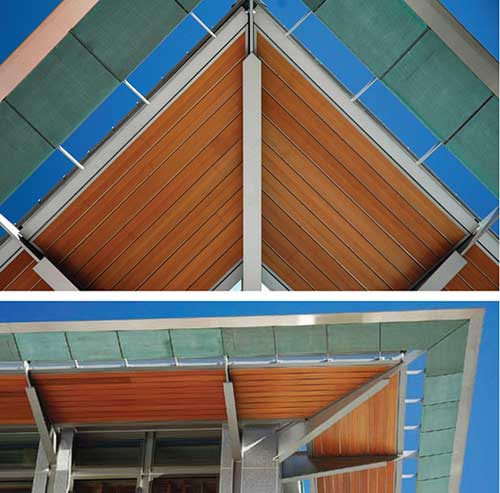 |
Western red cedar veneer was wrapped over an aluminum core to meet fire codes while maintaining design integrity at the University of California's Berkeley Campus Stanley Hall. Photo courtesy of Contact Industries |
"The substrate had to be non-combustible yet we wanted the look of wood, so veneer profile wrapping was a workable solution. The aluminum could be shaped according to our specifications and we were able to get the flat look of the wood from the underside that we wanted," says Renee Kajimoto, AIA, LEED AP, of the Zimmer Gunsul Frasca Architects, noting that after four years, the soffits have held up well without cracking or other damage.
While the soffits were an exterior application, they were well protected from direct contact with the elements. It is strongly recommended that components made with real wood veneer not be used in weather-exposed exterior applications. This is not for fear that the adhesive bond will fail, but only because, like any exposed wood product, the wood veneer itself must be refinished regularly to avoid degradation from weather exposure. Because such required regular maintenance is typically not a priority for owners/users, manufacturers recommend only the use of "maintenance-free" wrap materials such exterior-rated films with UV-protected wear layers in weather-exposed applications. These films are available in a wide range of wood grains, solid colors and design patterns and a variety of thicknesses.
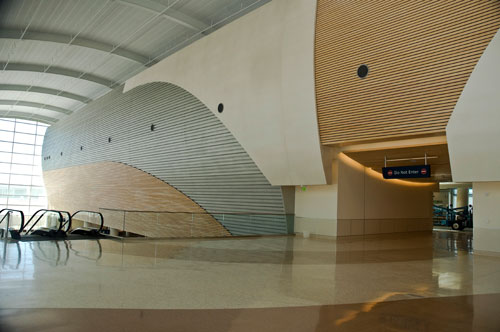 |
The design team for the San Jose International Airport adapted the veneer-over-aluminum technology displayed in the previous photo for their own use in providing the warmth of a wood interior combined with the safety of a class A fire rating. Photo courtesy of Contact Industries |
The vast majority of veneer profile wrapped and laminated products are used in interior non-direct weather affected situations.
They have applicability particularly where a metal substrate is may be required for code compliance reasons, such as door frames.
The exposed parts of the veneered frame can then be stained to match the door itself or the surrounding woodwork for a consistent aesthetic appearance.
Historically, when fire ratings were required, hollow core steel doors and frames were the only choice. Today, fire-rated frames-- both MDF core with intumescent, as well as conventional hollow core metal frames for single and double door openings-- are widely available profile wrapped in any wood species with ratings of 20, 45, 60 and 90 minutes
These are particularly suitable for installation in new hotel construction, public spaces and foyers, among other applications.
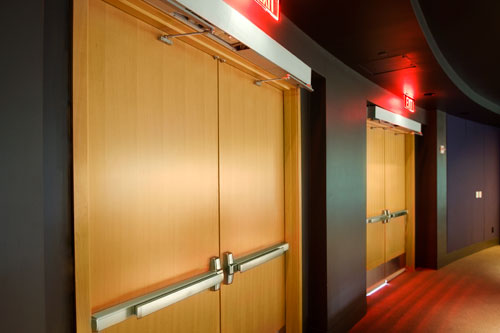 |
Veneer profile wrapping allows manufacturers to offer wood door frames that match the wood finish of architectural fire doors while maintaining fire ratings up to 90 minutes. Photo courtesy of Contact Industries |
Finishes. Veneer profile-wrapped products are often available factory pre-finished with stain and/or topcoat for color consistency, treated with an environmentally friendly durable ultraviolet (UV) cure.
Painted and top coat stain with environmentally friendly UV cures can be spray-applied resulting in full coverage of part profiles, such as window and door parts, as well as custom moulding components.
With applied stain colors and UV curing, volatile organic compound (VOC) and hazardous air pollution (HAP) emissions are virtually eliminated, the material coverage ‘cure’ is nearly instantaneous, and the product end result provides resistance to scratches and chemicals. Typically, factory-applied stains and UV coatings are more cost-effective than jobsite finishing and often results in a better quality product without generating emissions at the worksite.
Veneer and Films
Components can have been profile wrapped in more than 200 different natural wood veneer species, as well as a range of film materials.
Widely available are films and foils for interior or exterior use that are typically vinyl or impregnated cellulosic material imprinted with most any "look," including wood prints.
The most common profile wrapping option, say manufacturers, is Real Wood Veneer, which allows for consistent color and grain with minimal knots and mineral streaks.
Veneer is available pre-sanded, eliminating the need for grain filling. Veneers also offer the advantage of using exotic species that may be unavailable or cost prohibitive in solid lumber.
Manufacturers may offer flitch- and grade-matching to ensure visual appeal and consistency in the final product. A flitch is a set of individual veneer leaves sliced from a single log, and each flitch has its own distinct grain, color, width and other qualities. Sliced veneers from each flitch are bundled in the exact order in which they are cut, to more easily attain proper matching.
Reconstituted Veneers. Manufactured wood veneers are made to resemble certain wood species and are another option.
Reconstituted veneers are made from sustainably produced lumber dyed, glued and assembled into a lumber block, and then sliced from the edge of the block to produce veneers of the same thickness and color consistency. While reconstituted veneers may not have be what is normally considered a natural veneer, reconstituted veneer tends to have greater uniformity for applications requiring consistent pattern and color.
Characteristics of Profile Veneer Wrapped and Flat Laminates.
In the profile veneered wrapped process a "veneer" or laminate, .013 - .015 inches in thickness, is bonded to a profiled surface.
In the flat lamination process, a "veneer" or laminate, .031 to .125 inches in thickness, is bonded to a flat, rather than ‘profiled,’ surface.
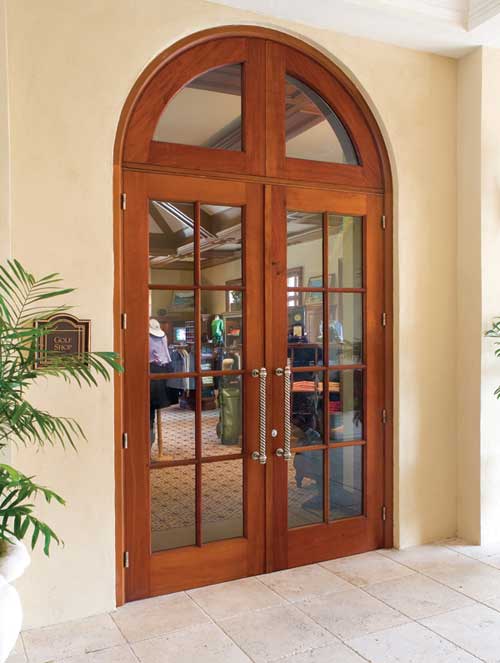 |
Flat laminates were used to meet hurricane criteria on the pro shop door at an upscale Florida resort. Photo courtesy of Contact Industries |
Therefore the principal differences between a wrapped veneer and a laminated veneer are the thickness of the veneer used in the product and the profile type
In order for a veneer to wrap over a moulded patterned profile, it needs to be thin enough to be pliable to cover profiles of various shapes
However, a thick veneer to be flat laminated is often more rigid.
A profile-veneered product has the veneer applied in a lineal, horizontal production process, whereas a flat laminated veneered product is a "batch" process through either a cold press or a radio frequency (RF) oven.
Whether flat-laminated or veneered, the cores are generally produced in the same manner.
A flat laminated component is often specified for products used in exterior applications and to achieve certain performance standards (such as meeting specified modulus of elasticity (MOE) or modulus of rupture (MOR)) that may be unattainable by a thin veneered component.
For example, flat laminates were used for the golf pro shop doors at an exclusive Florida golf resort, where aesthetics and strict adherence to Miami Dade Wind Load performance testing were key. The core material was specially designed solid lumber that was face glued to have sufficient durability in order to meet the criteria of the Miami Dade Hurricane Code. Specifically, a Douglas Fir LVL substrate with a measured modulus of elasticity and modulus of rupture was used to meet the hurricane code ratings. The project involved some 864 linear feet of stiles and 278 linear feet of rails fabricated from ¼-inch finger-jointed pine face and a ¾-inch finger-jointed pine band wrapped with ¼-inch face veneer of lustrous wood known as Khaya, or African mahogany, and ¼-inch Khaya edge band. Prior to installation, the components were tested to withstand the 58-70 psf load capacity standards set forth by the Hurricane Testing Laboratory.
Similarly, an LVL (laminated veneer lumber-- an engineered product composed of multiple layers of thin wood assembled with adhesives) substrate with pine veneer was used in a combination of wrapped and laminated parts at London's Falcon Wharf, a complex of 124 apartments with 17 floors of glass-enclosed balconies. Door stiles and window components were designed to perform under adverse climate conditions, notably significant changes in temperature and humidity, which would cause normal solid wood components to twist and check extensively. Doors and windows separate a glass-enclosed deck, which at times acts similar to a greenhouse for plants. During construction, temperatures often soared to 130° F, and the components functioned smoothly.
 |
At London's Falcon Wharf, door stiles and window components for enclosed decks were Douglas fir LVL with pine veneer to ensure dimensional stability under extreme conditions. Photo courtesy of Contact Industries |
Core Materials
Depending on the performance requirements of the finished product, the substrate or core might be specified or made of the following materials (or many adhered combinations of the following):
Softwood, hardwood, MDF, LVL, as well as roll form or extruded aluminum, steel, polyvinyl or fiberglass. Though cores can be made of virtually any stable material, finger-jointed softwood cores are generally recognized to be the most popular and economical substrates for mouldings and millwork.
This use of softwood fingerjoint lumber is consistent with wise wood resource management principles that require every harvested tree to be used to its maximum economic and environmental value.
Softwood cores can be fabricated from the lower grades of industrial lumber that might otherwise be rejected, because the profile wrapping and laminating processes allow for the coverage of visible ‘defects’ in the lower grade lumber core material.
This is particularly important in light of the fact that billions of cubic feet of useable low grade lumber are currently under-utilized.
If this waste wood could be transitioned to the supply chain, harvesting burdens would be reduced on forests, and billions of tons of embodied carbon dioxide sequestered, eliminating methane and other gases emitted by decomposing wood.
Research indicates that up to 50 percent of underutilized or waste wood material could be converted to serviceable solid wood products, with the remainder available for processing into byproducts - a situation where a 100 percent utilization rate could be achieved. These statistics indicate that an enormous amount of wood products can be manufactured without any additional timber harvesting.
The low-grade pine lumber most often used for most fingerjoint core substrates comes mainly from sustainably managed forests on relatively short rotations.
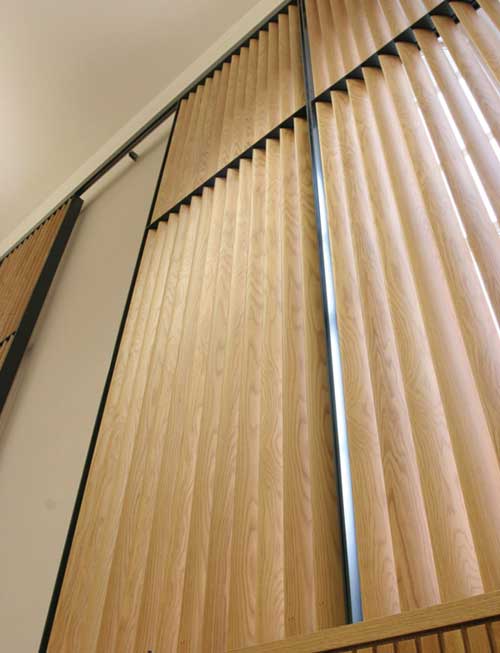 |
Extruded aluminum wrapped in white oak was the ideal solution for vertical blinds at London's King's College. Photo courtesy of Contact Industries |
The solid clear blank products used for veneer come from forestland that is being sustainably managed for significantly longer rotations.
Using the plentiful, faster-growing, shorter-rotation pine for core reduces pressure on natural forestlands and on less plentiful species.
The 50-1 resource efficiency ratio in using veneer achieved in profile wrapping allows all species to be utilized at an increased level of sustainability.
Further, because the low-grade pine core material is harvested on the shorter rotation, thereby generating good economic value, there is less pressure to convert these managed forests to other non-forest purposes, enabling them to continue to provide such benefits as carbon sequestering, wildlife habitat, soil and water retention and filtering, etc.
Despite its considerable resource efficient attributes, however, a soft wood substrate is may not always provide the product application answer.
Finger-jointed hardwood cores (which often are made from post-industrial recycled wood waste) are periodically specified where the intent may be to address a specific installation application.
NAUF MDF and Particleboard, in its range of product types, may be specified, but due to weight and possible exposure to moisture, is best selectively placed in strategic areas or products.
Offering engineering or other important options, alternate material substrates including aluminum, PVC, fiberglass and steel are often used for specific purposes, including ceiling panels and window and door components.
In applications where product weight is may present an issue, aluminum may function as an appropriate core material.
During a recent remodel, London's King's College used profile wrapping in creating vertical Venetian blinds. While designers liked the aesthetics of white oak lumber, it was deemed too heavy and too costly to be deployed in a window covering.
The college opted instead for extruded aluminum wrapped in white oak veneer for a dimensionally stable, fire-rated, aesthetically pleasing solution. Some 1,210 pieces totaling 92,503 lineal feet of vertical blinds were shipped with pieces delivered to exact measurements in made-to-order lengths.
Adhesives
To insure long term durability and adhesion the best veneer profile wrapped products are bonded with a polyurethane reactive moisture-curing hot melt adhesive (PUR).
Recognizing VOC emissions and industry concerns regarding the quality of adhesion, PURs contain no solvents, offering "green" strength and superior bond performance.
Accepted in many industries as a replacement for mechanical fasteners, moisture curing PURs are applied to a veneer and substrate in a thin adhesive line that sets begins to cross link on the production line, and becomes rigid and inert within 72 hours .
Formaldehyde-free emulsion polymer isocynates (known in the industry as EPIs) exterior adhesives are used in flat lamination. These adhesives cure through pressure and time in the appropriate production press.
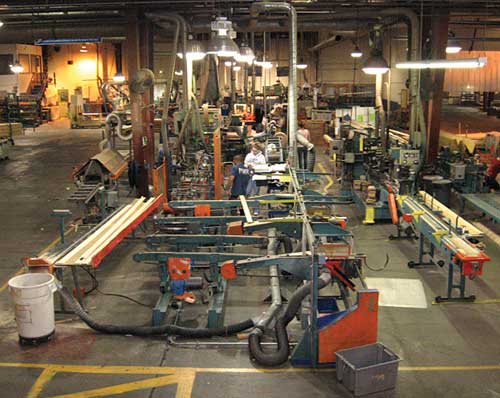 |
Substrate is profile wrapped with veneer on the cell, sanded and goes straight into a carton for shipment. Photo courtesy of Contact Industries |
Veneer Wrapping: From Design to the Production Process
Designers envision mouldings and millwork items in their projects from a number of perspectives, including, but not limited to:
- Finished profiles that represent the design intent.
- Appropriate species and protective top coat finishes.
- Appearance and/or aesthetic needs complementary to other products on the site
- Fit, form and function needs.
- Balanced integration with other materials on the site, including windows, doors, flooring, ceilings, tile, wall coverings, fire-related requirements, etc.
To assure the wisest use of the lumber resource, designers should consider specifying the application and the specification of profile wrapped or flat laminated products on project plan documents.
Responding to these designers' project plans and requirements, manufacturers will then appropriately identify the size and location of the component, and suggest the appropriate pertinent substrate and veneer material for the product size, application and location.
The manufacturer will translate the profile of the component and/or trim designed by the architectural professional into a shop floor manufacturing plant CAD approval drawing.
Upon review and approval, an order is placed, and the manufacturing process begins. The substrate is molded to the pattern of choice, and wrapped in the desired veneer.
Prepping the Veneer. A good profile wrapping process begins with premium veneers that are climate controlled to prevent cracking and are processed from a random width and length flitch stock to assure the most efficient and prudent use of the resource.
This process also allows minor lumber defects to be cut out so that a clear specified product will result, preserving the resource and saving time during installation.
For optimum results, the veneer must be properly prepared in a multi-step process that includes the following:
- The appropriate clear lumber slicing blank is selected and inserted into a water-filled autoclave; a "vacuum" is drawn and water introduced into, and allowed to penetrate all the lumber's cells.
- The "soaked" slicing blank is introduced to the horizontal veneer slicer.
- After the large draw knife slices the veneer from the blank to the appropriate thickness, the veneer is introduced to a dryer where moisture is dropped gently to nine percent.
- The veneer is finger-jointed together into lineal rolls for fleece backing and sanding.
- The back of the veneer is fleeced in a lineal process with heat, adhesive and pressure. The 25- or 50-gram thickness fleece is a nylon material used to bind together the veneer's fiber, and make it more pliable for profile wrapping, enabling it to be wrapped around curves, without changing its physical appearance. The backer should be the proper weight to allow the product to wrap without cracking.
- The veneer is sent through a four-head sander and sanded with a 180-grit finish to achieve optimum smoothness prior to adherence to the core material.
Fabricating the Core. As noted earlier, the predominant core material - is finger-jointed common grades of pine.
In the rough mill this material is processed, finger-jointed and edge- and/or face- glued into core blanks of appropriate dimensions to mould into the shape desired.
If profiling is needed, these blanks are run through a moulder to fabricate the finished core appearance.
In many cases, the core material may require engineering in order to achieve certain performance characteristics.
These would include, such needs as meeting fire codes, weight reduction or requiring assured strength or dimensional stability.
Typically these decisions are made jointly by the manufacturer and architect or end customer, taking into account the product's use, performance expectations and visual appearance, and then value engineering for the optimum combination of performance, aesthetics, environmental impact, and cost factors.
At the Quintiles Pharmaceuticals headquarters in North Carolina's Raleigh-Durham area, architects modified plans for paneling and beams based on stability and cost considerations. The original design called for solid Afromosia tongue and groove paneling and overhead 2-foot x 10-foot beams. Afromosia is a relatively rare, African hardwood species. Using solid lumber for the paneling would have been feasible, but cost-prohibitive and an unnecessary depletion of the Afromosia resource. The 12-foot and 16-foot beams would have been nearly impossible to find in solid wood and even if they could be located, solid wood would have been subject to dimensional stability issues such as warping and checking.
Instead, architects opted for engineering tongue and groove paneling using a pine substrate and Afromosia veneer. The substrate for the beams was fabricated from LVL to address the dimensional stability issues, then wrapped in a two-pass operation in which each beam was end-capped with veneer to give the appearance of a solid piece. The project exemplifies diverse processes, well-conceived engineering, and wood products dovetailing to provide the appropriate product for the job. The wrapped beam met the requirements of dimensional stability, while being cost effective and resource saving, by replacing the originally intended solid Afromosia beams.
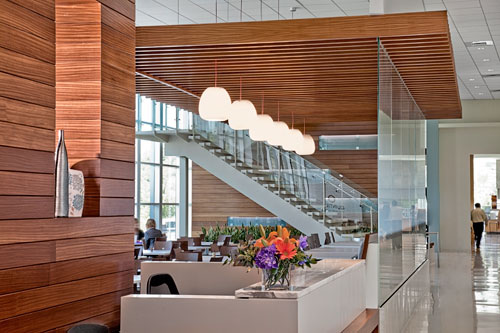 |
Afromosia veneer over LVL rather than solid lumber was a cost-effective, dimensionally stable, resource-saving choice at the Quintiles Pharmaceuticals headquarters, a LEED Silver building in North Carolina. Photo courtesy of Contact Industries |
Applying Adhesive. In the actual manufacturing process, a roll of veneer is loaded onto the profile wrapping machine and a length of core material is fed into the front end of the machine process.
Adhesive is applied, and the veneer is laid over the core in the lineal process. A series of profiled rollers applies veneer to core pressure at strategic points to ensure optimum adherence.
This is a critical factor as poor adhesion can compromise the product, with incomplete adhesive coverage causing delamination and/or too much adhesive resulting in a faulty bond and excess glue seeping through product edges.
It is up to the manufacturer to identify the proper adhesive formulation, viscosity and glue spreads required to assure Type 1 (exterior rated) adhesion. Glue spreads may be electronically monitored depending on the adhesive dispensing system used.
It is important to match the proper type of hot melt adhesive with the type of substrate because one adhesive type will not successfully wrap all types of substrates.
Prior to adhering veneer to alternate material substrates (fiberglass, PVC, aluminum, steel, etc.), the manufacturer must conduct a Dyne test to determine the surface friction level of the substrate to assure long-term adhesive integrity.
A Dyne measurement is simply the measurement of that surface friction of the material, which will then direct the manufacturer to the appropriate adhesive.
 |
The profile wrapper carriage forms the veneer around the substrate. Photo courtesy of Contact Industries |
Adhesive Integrity Testing
While not required by code or other standards organization, manufacturers may conduct their own quality assurance testing to confirm that adhesives will maintain their integrity, long term, to avoid delamination on their wrapped products.
The test for this purpose is known as the Boil test.
Many manufacturers perform a four-hour product boil test as an in-house quality check on the previous day's production that has been allowed to cure for a minimum of one day.
Random samples are cut from production run material at the ends and center of parts.
The samples are then subjected to four hours of immersion in boiling water and then visually checked for glue failure.
In the Type 1 Adhesion Assurance Boil test, similar samples are submerged in boiling water for four hours, placed in a convection oven at 145° F for twenty hours, and the cycle is then repeated.
For the samples to pass they must show no evidence of de-lamination through all stages of the test.
Veneer- or vinyl-wrapped products are subject to the same test, but allowed to cure a minimum of two days before being visually checked for glue failure.
 |
|
Photo courtesy of Contact Industries |
For superior products, architects may want to investigate whether the manufacturer and or/its products have pertinent certifications and have met a variety of testing capabilities. Among those to be considered are the following:
- ISO 9001:2008 Certification
The 2008 version is the fourth edition of the quality management system standard, which was first published in 1987 and continues to be used world-wide. - Kitchen Cabinet Manufacturers Association (KCMA) Standards
These standards concern finish testing and durability. KCMA certification is a testing process designed to challenge the product's durability at an accelerated pace. KCMA tests the ability of the finish to withstand prolonged hot and cold cycles, complete immersion in abusive substances typically found in the kitchen and bath, and exposure to a detergent and water solution for at least 24 hours. In order to pass, "The finish must show no appreciable discoloration, stain, or whitening that will not disperse with ordinary polishing and no indication of blistering, checks, or other film failure." - In-line Statistical Process Control (SPC)
A method for achieving quality control in manufacturing processes, SPC is a set of methods using statistical tools such as mean, variance and others, to detect whether the process observed is under control. - Compliance with Window and Door Manufacturers Association (WDMA) Hallmark I.S.4 Water Repellent Preservative Non-Pressure Treatment for Millwork
Considered a mark of excellence among architects, contractors and other specifiers and accepted industry-wide, the WDMA-sponsored Hallmark Certification Program provides an easily recognizable means of identifying products manufactured in accordance with appropriate WDMA and other referenced performance standards. - Temperature/Humidity Chamber Testing
Originally developed as a testing protocol in the airline industry, this test checks for proper adhesion under extreme temperature, humidity and even altitudinal changes.
A Palette of Possibilities
Considering that logs used for solid lumber generally yield pieces that are over an inch thick at minimum, veneers at a fraction of an inch thick greatly enhance the yield of a tree’s resource, placing far less stress on a valuable natural resource.
Veneer's inherent sustainability, together with continually evolving technology in all aspects of the profile wrapping industry has provided the design industry with an exciting palette of possibilities for bringing the beauty of wood into the built environment in a way that's resource-sensitive, efficient and cost-effective.
 |
Contact Industries pioneered veneer profile wrapping in the 1980s and has used the technology, along with flat laminating, to produce moulding and millwork products and components ever since. An industry leader in quality assurance and innovation, Contact Industries is FSC Chain of Custody certified as well as ISO 9001-2008 registered and holds Hallmark Certification from the Window and Door Manufacturers Association. www.contactind.com |
